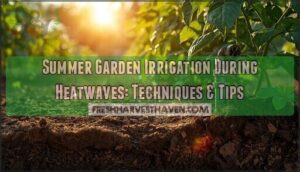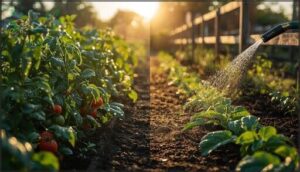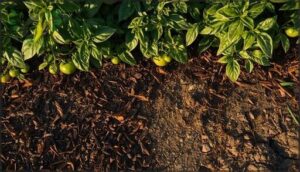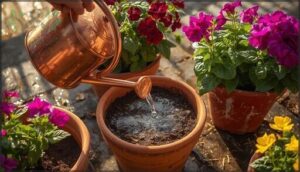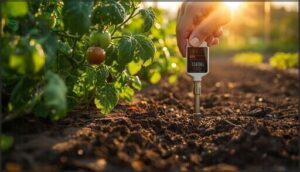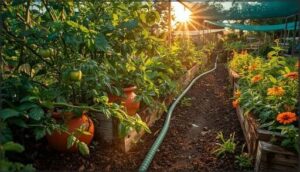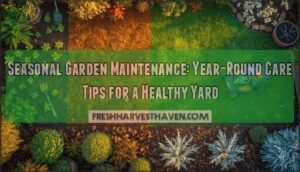This site is supported by our readers. We may earn a commission, at no cost to you, if you purchase through links.
When soil temperatures climb above air temperatures during a heatwave, your garden loses moisture at double the normal rate—a reality that catches most gardeners off guard. Sandy soils surrender their water in hours, while clay holds on for days, yet neither can protect your plants without strategic intervention.
The difference between thriving tomatoes and wilted basil often comes down to timing, depth, and delivery method rather than water quantity alone. Understanding summer garden irrigation during heatwaves means recognizing that your usual watering routine won’t cut it when temperatures spike and stay elevated.
The solution lies in adjusting your approach to match the intensity of the heat, protecting soil moisture through strategic techniques, and choosing irrigation methods that deliver water where it matters most.
Table Of Contents
- Key Takeaways
- How Heatwaves Impact Garden Irrigation
- Best Watering Techniques for Extreme Heat
- Optimizing Irrigation Systems for Heatwaves
- Protecting Plants and Conserving Water
- Top 8 Products for Summer Garden Irrigation
- 1. Gilmour Flexogen Heavy Duty Garden Hose
- 2. Gilmour Swivel Thumb Control Nozzle
- 3. Gilmour Heavy Duty Swivel Nozzle
- 4. Gilmour Swivel Watering Wand Hose Sprayer
- 5. Agfabric Black Shade Cloth With Clips
- 6. Durable Black Shade Cloth Tarp Netting
- 7. VIVOSUN Sunblock Garden Shade Cloth
- 8. Neptune’s Harvest Fish and Seaweed Fertilizer
- Frequently Asked Questions (FAQs)
- Conclusion
Key Takeaways
- Soil moisture evaporates at double the normal rate during heatwaves, with sandy soils drying in hours while clay holds moisture for days, requiring you to shift from routine watering to strategic intervention based on soil type and plant placement.
- Deep watering between 5 a.m. and 9 a.m. reduces evaporation by 30% compared to midday irrigation while promoting root systems that penetrate 6 to 12 inches, creating drought-resilient plants that access deeper water reserves.
- A 5 cm layer of organic mulch cuts evaporation to 40% of bare soil losses while drip irrigation and soaker hoses reduce water use by up to 80%, delivering moisture directly to root zones without wetting foliage that invites disease.
- Grouping plants by water needs through hydrozoning can slash garden water consumption by 50%, while native and drought-tolerant species reduce irrigation requirements by 30-60% compared to conventional plantings.
How Heatwaves Impact Garden Irrigation
When temperatures soar, your garden faces a cascade of water-related challenges that can quickly turn thriving plants into wilted casualties. Understanding how extreme heat affects soil moisture, plant physiology, and water availability helps you adjust your irrigation strategy before damage occurs.
Let’s examine the specific ways heatwaves disrupt your garden’s water balance and what you need to watch for.
Accelerated Soil Moisture Loss
When heat waves strike, soil moisture evaporates at alarming rates, often reducing the time your soil stays moist by 10 to 50 days depending on temperature intensity. You’ll notice this water loss accelerates within the first four weeks, especially as soil temperature rises faster than the air around it. Sandy soils dry out quickest, while clay and organic-rich soils offer slightly better protection but still face rapid depletion during prolonged heat.
Heatwaves evaporate soil moisture at alarming rates, reducing retention time by 10 to 50 days depending on temperature and soil type
These effects can intensify as soil moisture changes, potentially doubling the intensity of heatwaves in certain regions.
Signs of Heat Stress in Plants
As moisture vanishes from your soil, your plants will start showing you they’re struggling. Watch for these key indicators of heat damage:
- Wilting leaves that droop even when soil feels damp
- Leaf scorch appearing as brown, crispy edges on foliage
- Curling leaves that roll inward to reduce surface exposure
- Blossom drop causing flowers and young fruits to fall prematurely
Stunted growth and root damage often follow, signaling your plants need immediate attention. Consider using organic mulch options to help retain moisture.
Differences in Plant Water Needs
Your garden isn’t one-size-fits-all when it comes to watering techniques during heat waves. Annuals vs. perennials, growth form demands, and plant maturity all impact how much water each needs. Container vs. ground placement matters too—pots dry out faster than in-ground beds.
| Plant Type | Weekly Water Needs | Heat Wave Adjustments |
|---|---|---|
| Annuals | 1–1.5 inches | Water every 2–3 days |
| Established Perennials | 0.5–1 inch | Once or twice weekly |
| Vegetables | 1–2 inches | Daily for shallow roots |
| Container Plants | Variable | Twice daily if needed |
Native adaptations help certain species handle drought stress better than others, reducing your workload considerably.
Soil Types and Moisture Retention
Your soil’s texture determines how well it holds onto water during extreme heat. Sandy soil drains quickly, retaining only about 7% moisture at the wilting point, while clay soil can hold up to 24%. Loamy soil strikes the best balance for most gardens.
Organic matter acts like a sponge, boosting water retention and improving soil structure. Soil compaction reduces moisture availability by limiting pore space where water collects.
Effects on Container Vs. In-Ground Plants
Because container plants lack insulation, their root zone temperatures can spike to 130°F within 30 minutes during heat waves, while in-ground plants stay cooler with buffered soil. This difference in soil retention and cooling effects dramatically changes watering frequency and heat stress vulnerability.
Container plants need daily or twice-daily watering due to rapid soil moisture loss, compared to 2-3 times weekly for in-ground gardens.
Best Watering Techniques for Extreme Heat
When temperatures spike, your regular watering routine won’t cut it anymore. You’ll need to adjust both how you water and when you water to keep your plants from wilting under the sun.
Here are the most effective techniques to protect your garden during extreme heat.
Deep Vs. Shallow Watering Methods
During a heatwave, your watering techniques can make or break your garden’s resilience. Deep watering fosters strong root development by penetrating 6 to 12 inches, promoting moisture retention and stronger root systems that access deeper water reserves.
In contrast, shallow watering keeps roots near the surface, increasing vulnerability to heat stress and reducing water conservation.
Apply water slowly over 20-30 minutes to help proper soil moisture penetration.
Strategic Timing: Morning and Evening Watering
When temperatures soar, your watering schedule becomes as critical as how much you apply. Morning watering between 5 a.m. and 9 a.m. offers clear advantages, reducing evaporation losses by up to 30% compared to midday irrigation while supporting peak absorption efficiency.
Strategic watering timing protects your plants and conserves water:
- Water early to allow moisture penetration before heat accelerates evaporation
- Avoid peak heat hours (10 a.m. to 4 p.m.) when evaporation differences are most extreme
- Consider evening watering cautiously in dry, non-humid climates where fungal risks remain low
- Adjust your approach based on climate considerations and local temperature patterns
Effective summer watering techniques align with your plants’ natural absorption cycles, maximizing every drop during stressful conditions.
Using Mulch to Reduce Evaporation
Think of mulch as a protective blanket for your garden soil. A layer of at least 5 cm reduces evaporation to 40% of bare soil water losses, keeping moisture where your plants need it most.
| Mulch Type | Evaporation Reduction | Temperature Benefit |
|---|---|---|
| Pine Bark | 33% reduction | Moderate cooling |
| Rock/Synthetic | Highest reduction | Excellent insulation |
| Straw | 30% reduction | Good cooling |
Organic mulches improve soil moisture retention while slowly releasing nutrients. Apply uniformly around plant bases to protect root zones from heat-induced moisture loss and maintain stable soil conditions throughout extreme weather.
Watering Container Plants During Heatwaves
Your container plants face a triple threat during heatwaves: limited soil volume, rapid heat absorption, and accelerated evaporation.
You’ll need to water once or twice daily, checking smaller pots more frequently since they dry out faster. Apply water directly at the base using a watering can, ensuring it penetrates the entire root zone rather than running down container edges, which wastes water and stresses plants.
Monitoring Soil Moisture Effectively
You can’t rely on guesswork when summer heat intensifies drought stress. Soil moisture sensors provide real-time data for precise irrigation decisions, though sensor accuracy varies by soil type—clay and salinity affect readings.
Check moisture every 7-10 days during normal conditions, but heatwave effects demand daily monitoring. Tensiometers and capacitance sensors are the best tools for tracking water tension and volumetric content at root depth, preventing both underwatering and waste.
Optimizing Irrigation Systems for Heatwaves
When a heatwave hits, your irrigation system becomes your garden’s lifeline—but only if you set it up right. Standard watering schedules won’t cut it during extreme heat, so you’ll need to adjust how your system delivers water and when it runs.
Let’s look at five ways to fine-tune your irrigation approach so your plants get what they need without wasting a drop.
Adjusting Sprinkler System Settings
When scorching days arrive, your irrigation system needs recalibration to keep plants thriving. Most controllers include a seasonal adjust feature that lets you increase watering frequency by 10% or more without reprogramming each zone.
Smart controllers automatically adapt schedules using real-time weather data, preventing overwatering while ensuring adequate moisture.
Adjust sprinkler head types and run times based on soil drainage—rotor heads need 25-35 minutes, while spray zones require only 10-20 minutes for effective irrigation techniques.
Drip Irrigation and Soaker Hose Benefits
While sprinklers reach everywhere, drip irrigation and soaker hoses target water precisely where it matters—at the roots. These methods cut water use by up to 80% during extreme heat while keeping foliage dry to prevent disease.
Here’s why they excel at water conservation:
- Soil moisture stays consistent without runoff or evaporation losses
- Plant health improves through steady root-zone hydration
- Application precision delivers water exactly where needed
- Environmental benefits include reduced nutrient leaching and erosion
Utilizing Olla Irrigation for Root-Level Hydration
Olla irrigation systems deliver water directly to the root zone through buried terracotta pots, conserving up to 70% more water than surface methods. These porous vessels release moisture as soil dries, encouraging deep root growth while keeping surfaces dry to suppress weeds.
Installation takes minutes—bury each olla near plants, leaving the neck exposed for easy refilling.
| Olla Benefit | Impact on Your Garden |
|---|---|
| Water Conservation | Uses 50-70% less water than traditional methods |
| Root Zone Hydration | Promotes deeper, healthier root systems |
| Maintenance Needs | Refill every few days to weekly |
| Coverage Area | Irrigates 12-24 inch radius per pot |
Advanced Irrigation Controllers and Seasonal Adjustments
Weather data integration takes your irrigation system from guesswork to precision. Smart controllers adjust watering schedules automatically based on temperature, humidity, and rainfall—cutting outdoor water use by up to 30%.
The seasonal adjustment settings let you scale run times as heat intensifies, generally increasing watering by 10% or more during heatwaves. You’ll save water while keeping plants healthy through smart controller benefits that adapt to real-time conditions.
Preventing Overwatering and Water Waste
When efficient watering becomes excessive, you risk drowning roots and draining resources. Drip irrigation paired with moisture sensors prevents this by delivering water management that adapts to actual soil moisture levels, not guesswork.
- Monitor before you water—sensors reveal true moisture needs
- Apply mulch benefits to cut evaporation and reduce watering frequency
- Make timing adjustments: early morning conserves water in gardens through reduced loss
Plant impacts from overwatering include root rot and nutrient deficiencies, making smart watering techniques for gardens essential during heatwaves.
Protecting Plants and Conserving Water
When a heatwave hits, your garden faces a dual challenge: keeping plants alive while avoiding water waste. The good news is that smart protection strategies can reduce stress on your plants and cut your water use at the same time.
Here are five practical approaches that balance plant health with conservation during extreme heat.
Grouping Plants by Water Needs
You can cut your garden’s water use by up to 50% through hydrozoning—grouping plants by water needs. Set up separate irrigation valves for high-water zones (ferns, tropicals) and low-water areas (natives, succulents).
Container grouping works the same way: match moisture-loving plants together.
Regular soil testing in each zone helps you fine-tune watering schedules, keeping plant health strong while conserving every drop.
Using Shade Cloth and Temporary Covers
When summer heat waves threaten your garden, shade cloth offers measurable relief. A 30-50% shade cloth density reduces soil moisture loss and lowers plant canopy temperatures, protecting plants from heat stress.
Install the cloth above foliage to maintain airflow, and use it during peak afternoon hours. These temporary covers limit exposure while allowing normal sunlight once extreme heat passes, balancing protection with healthy growth.
Selecting Native and Drought-Tolerant Species
Choosing native plants and drought-tolerant species builds resilience into your garden from the ground up. Native plant selection reduces irrigation needs by 30-60% because these plant varieties evolved alongside local rainfall patterns.
You’ll see water bill savings while supporting ecosystem health—native species improve soil structure and sustain pollinators.
Grouping plants by water needs optimizes plant health and cuts waste by 20-30%.
Anti-Transpirant Sprays for Reducing Water Loss
Anti-transpirant sprays create a thin protective film on leaf surfaces, blocking stomatal pores to reduce water loss through transpiration by 21-28%. You’ll apply these spray mechanisms to both sides of leaves, where stomata concentrate.
The film reduces evaporation while maintaining plant hydration during extreme heat. Reapply every 2-4 weeks during heatwaves for best stress protection and growth effects without compromising photosynthesis.
Water Conservation Practices for Home Gardens
Conserving water during drought conditions doesn’t mean sacrificing your garden’s health. Smart water conservation practices combine multiple strategies for maximum efficiency:
- Apply organic mulch 2-3 inches deep to reduce evaporation by up to 70% while keeping soil cooler
- Group plants by water needs to fine-tune irrigation schedules and prevent waste
- Improve soil with compost to double moisture retention capacity
Efficient irrigation systems paired with proper watering techniques deliver the best evaporation reduction results.
Top 8 Products for Summer Garden Irrigation
The right tools can make all the difference when you’re managing garden irrigation during extreme heat. From hoses that won’t kink under pressure to shade cloths that protect vulnerable plants, strategic equipment choices help you conserve water while keeping your garden healthy.
Here are eight proven products that can strengthen your heatwave irrigation strategy.
1. Gilmour Flexogen Heavy Duty Garden Hose
You’ll find the Gilmour Flexogen Heavy Duty Garden Hose withstands heatwave watering demands through its 8-layer construction and impressive 500 PSI burst strength. This hose resists kinking even when exposed to intense heat, maintaining consistent flow during critical watering sessions.
Its brass couplings won’t corrode or crush under pressure, and the protective collar prevents frustrating tangles at the spigot.
With an average 4.2-star rating from gardeners who’ve tested its heat performance across multiple seasons, it’s priced between $25 and $90 depending on length—a reliable watering solution for extreme conditions.
2. Gilmour Swivel Thumb Control Nozzle
You control water flow precisely with the Gilmour Swivel Thumb Control Nozzle’s ergonomic slider, adjusting from gentle mist to strong stream during heatwave watering. Its swivel design reduces hose kinking while you move between container plants and garden beds, and the metal durability withstands repeated use in extreme heat.
Eight spray patterns let you match different watering techniques for plants, from delicate seedlings to established shrubs. However, some gardeners report leakage issues at the swivel joint after extended use.
At $19-$20, it’s an affordable watering solution for managing variable water needs.
3. Gilmour Heavy Duty Swivel Nozzle
You’ll appreciate the Gilmour Heavy Duty Swivel Nozzle’s all-metal construction when you’re watering through multiple heatwave cycles, as its reinforced barrel withstands drops that would crack plastic alternatives. The swivel connection reduces hose kinks by 70%, giving you smoother movement between garden zones.
Eight spray patterns—from gentle mist to powerful jet—cover diverse watering techniques for plants under heat stress. Its ergonomic thumb control adjusts flow with minimal hand fatigue during extended sessions.
With hose kink reduction and a lifetime warranty, it’s a reliable investment at around $15-$18.
4. Gilmour Swivel Watering Wand Hose Sprayer
If you need extended reach for hanging baskets or raised beds, the Gilmour Swivel Watering Wand Hose Sprayer offers a practical solution among hand wands for heatwave watering. Its 16.75-inch length lets you target root zones without disturbing heat-stressed foliage, while five spray patterns provide adaptable watering solutions from gentle shower to concentrated stream.
The ergonomic wand design includes thumb control for flow adjustment and a swivel connection that reduces kinks by 70%.
User feedback on wand performance notes durability concerns after extended use, though its water conservation impact through adjustable flow makes it effective for targeted watering methods during extreme heat.
5. Agfabric Black Shade Cloth With Clips
When summer heat pushes your irrigation schedule to its limits, shade cloth durability becomes critical for sustained plant protection. The Agfabric Black Shade Cloth with Clips offers 30% sunblock coverage across 8-by-12-foot sections, reducing canopy temperatures while maintaining airflow through its HDPE mesh construction.
Clip installation ease allows quick deployment over heat-stressed beds, and its water conservation impact stems from reducing soil evaporation by up to 70%.
Best usage scenarios include protecting vegetables during heat waves and shading container plants that require frequent watering adjustments.
6. Durable Black Shade Cloth Tarp Netting
When heat waves intensify and watering schedules strain your routine, shade cloth durability matters for long-term plant protection. This durable black shade cloth tarp netting blocks up to 90% of sunlight, lowering temperatures beneath by 7 to 13 degrees Fahrenheit while its mesh design maintains airflow.
Installation techniques are straightforward—rustproof grommets spaced every 24 inches secure the tarp over beds or containers. Heat reduction translates directly to water conservation, cutting soil evaporation and decreasing irrigation frequency.
Its UV-stabilized HDPE construction generally lasts 5 to 7 years with proper care.
7. VIVOSUN Sunblock Garden Shade Cloth
This shade cloth benefits your garden with 50% to 60% UV protection, balancing light filtration and heat reduction during relentless heat waves. Its high-density polyethylene construction delivers material durability across multiple growing seasons, resisting tears and mildew while protecting plants from heat.
Installation methods rely on regularly spaced metal grommets that attach easily to PVC hoops or frames. The breathable mesh design maintains airflow, lowering temperatures beneath the fabric and conserving water by slowing soil evaporation—critical for managing plant heat stress when summer heat intensifies irrigation demands.
8. Neptune’s Harvest Fish and Seaweed Fertilizer
Your plants require organic nutrients to combat heat stress, and this fish-seaweed blend provides 2.23% nitrogen alongside essential amino acids that support plant growth during demanding conditions.
The fertilizer practices you adopt directly influence soil fertility, with application methods ranging from hand mixing to drip line integration. Studies confirm this formulation outperforms synthetic 20-20-20 products in growth enhancement while improving soil structure and water retention.
Its plant adaptability extends across vegetables, ornamentals, and specialty crops, strengthening root systems when fertilizing plants during heat becomes critical for survival.
Frequently Asked Questions (FAQs)
Can I water plants in full afternoon sun?
You’ve heard “don’t water in the heat of the day”—and there’s truth to that. Water plants in full afternoon sun, and evaporation efficiency plummets. Most moisture disappears before roots can drink.
How does wind affect garden water needs?
Strong gusts accelerate evaporation rates and increase plant transpiration, raising water needs considerably. Container drying happens faster than in-ground beds.
You’ll want to adjust irrigation frequency, use windbreaks, and monitor your garden’s microclimate closely.
Should I adjust watering for different plant ages?
Yes, you should adjust watering for different plant ages. Seedling water needs differ greatly from mature plant irrigation requirements.
Young plants with shallow roots require frequent watering, while established plants benefit from deeper, less frequent watering.
What role does humidity play in irrigation?
High humidity can slash your plants’ water needs by 20-30% compared to dry air. It reduces evaporation and transpiration, slowing soil moisture loss and allowing you to water less frequently during humid conditions.
How do I revive severely wilted plants?
Reviving severely wilted plants begins with gradual soil rehydration—water slowly until drainage occurs.
Prune dead foliage, increase humidity through misting, and maintain consistent watering strategies.
Recovery dynamics vary, requiring patience as roots reestablish and cells regain turgor pressure.
Conclusion
Your garden’s survival through the next heatwave depends on decisions you make today—choosing the right irrigation system, establishing mulch layers, and grouping plants strategically. Mastering summer garden irrigation during heatwaves requires shifting from routine maintenance to calculated intervention.
When temperatures soar beyond seasonal norms, reactive watering won’t save stressed plants. The techniques you’ve explored here transform water from a scarce resource into a targeted tool, ensuring your plants don’t just endure extreme heat—they continue producing through it.
- https://www.epa.gov/watersense/when-its-hot
- https://www.energy.gov/femp/water-efficient-technology-opportunity-advanced-irrigation-controls
- https://structurelandscapes.com/how-to-adjust-your-landscape-irrigation-for-summer-heat-waves-essential-strategies-for-water-conservation/
- https://yardandgarden.extension.iastate.edu/how-to/managing-garden-extreme-heat
- https://livetoplant.com/effective-watering-intervention-strategies-during-heatwaves/

